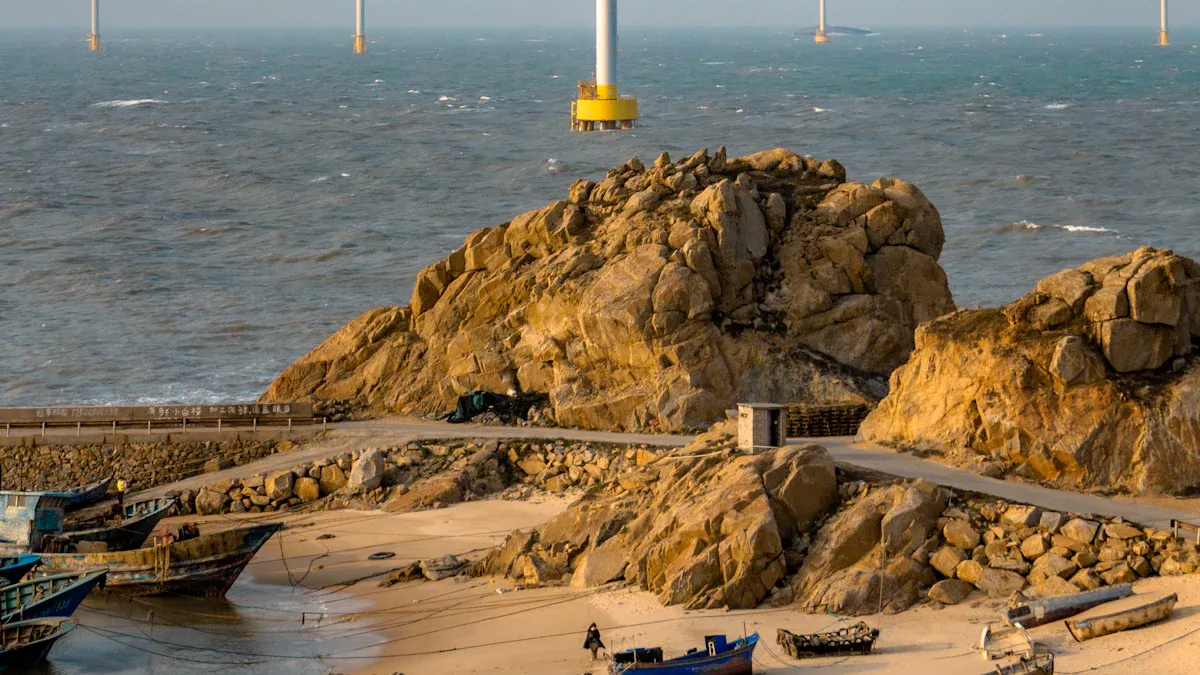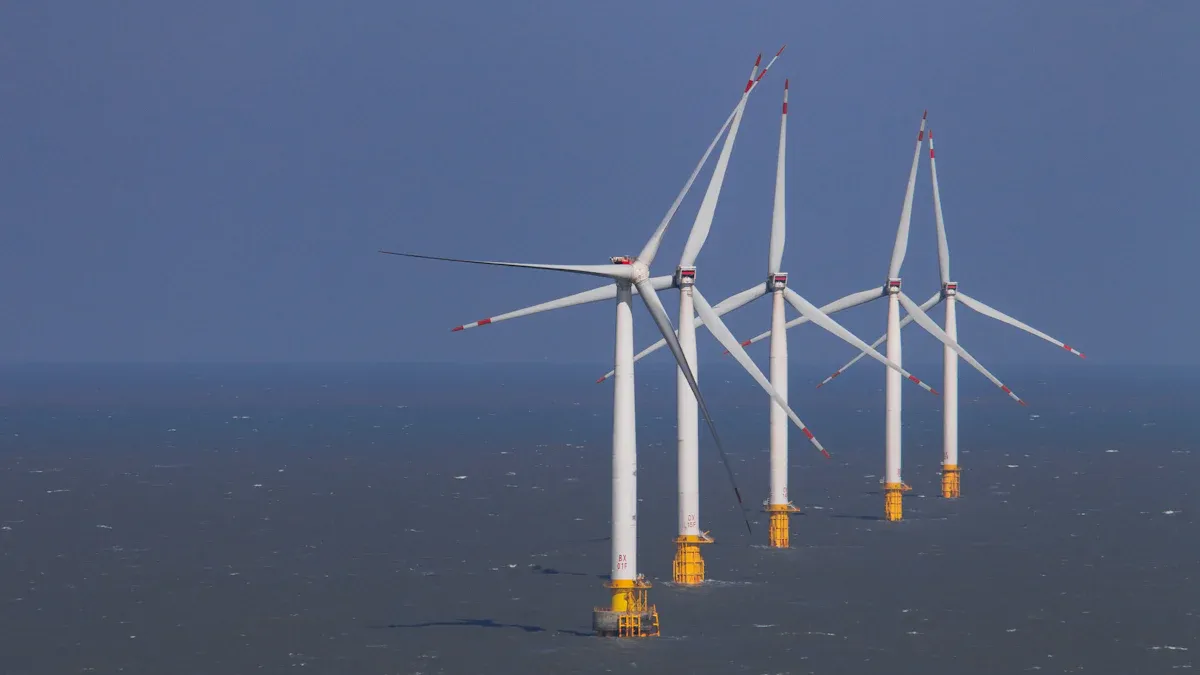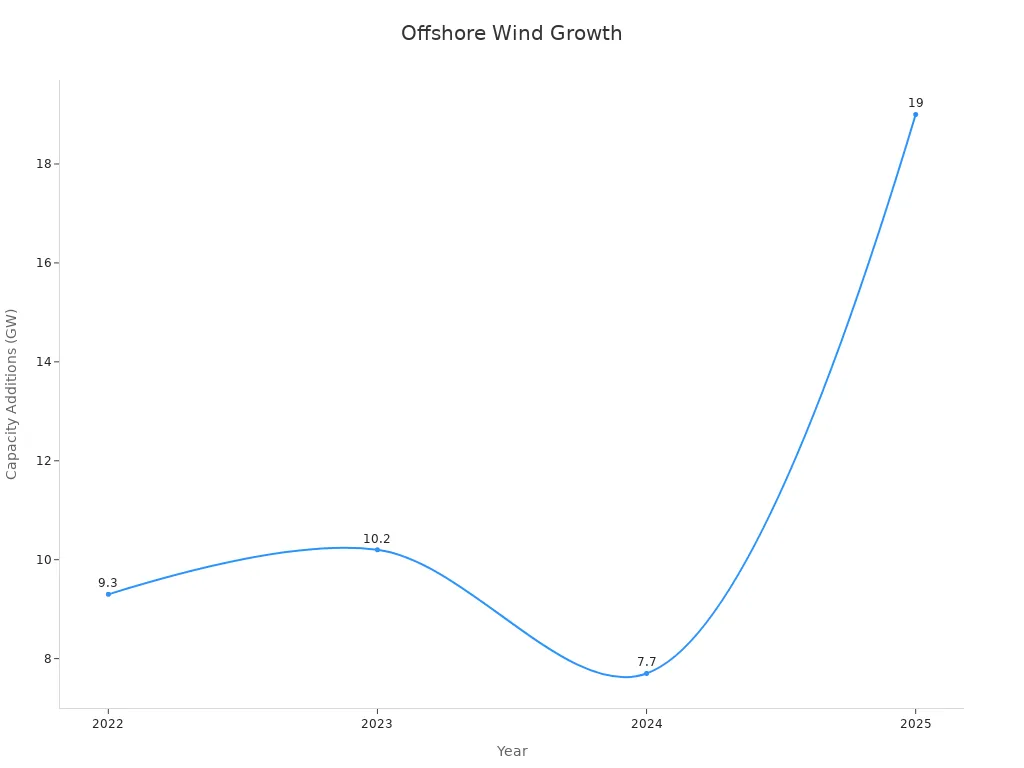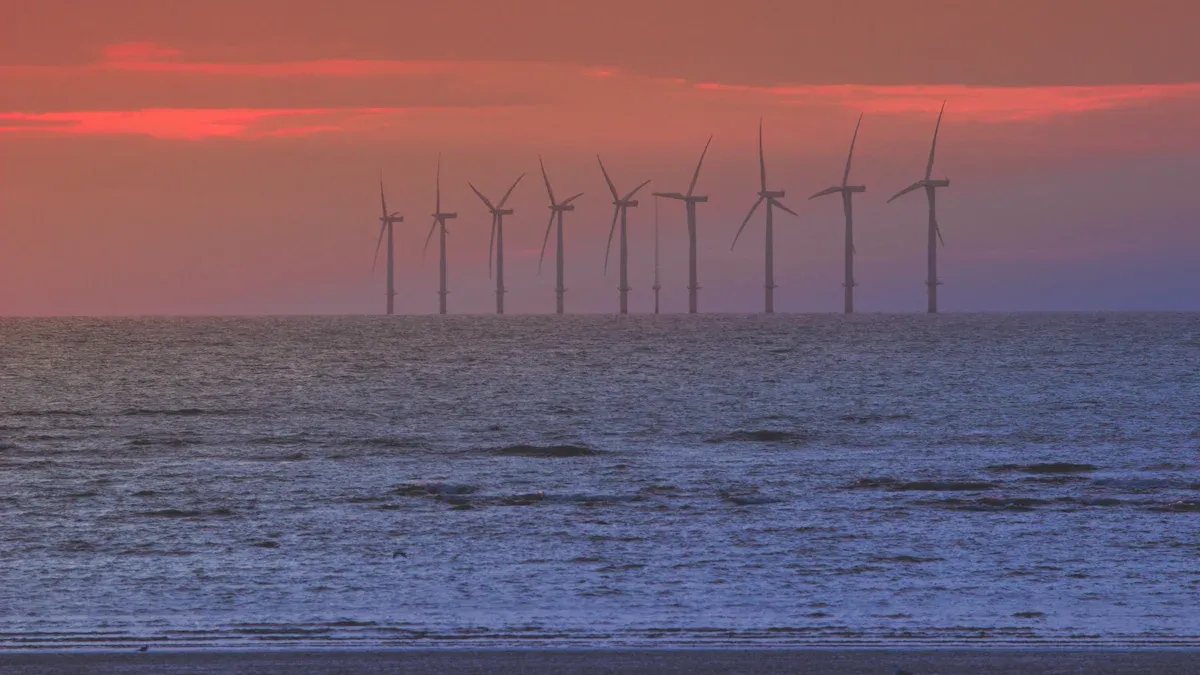
Europe’s offshore wind sector is surging ahead, fueled by ambitious renewable energy targets and groundbreaking innovations. The European Union’s Green Deal, aiming for climate neutrality by 2050, has sparked a wave of investments in wind energy projects. This momentum has created an unprecedented demand for forged wind turbine shafts, which are vital for modern turbine designs.
Advancements in digital technologies, like IoT and AI, are revolutionizing forging processes. These innovations enable manufacturers to produce high-strength components that meet the rigorous demands of offshore environments. As turbines grow larger and more powerful, the need for durable and efficient components becomes even more critical. Forged shafts play a pivotal role in ensuring reliability and performance, making them indispensable in Europe’s renewable energy journey.
Key Takeaways
- Europe’s offshore wind power is growing fast, with 187 GW expected by 2030. This increases the need for strong wind turbine shafts.
- These shafts are very important for turbines. They give the strength and toughness needed to handle tough ocean weather.
- New technology, like stronger materials and smart monitoring, makes these shafts work better and last longer in turbines.
- Government support and big spending on clean energy are helping the wind turbine shaft industry grow.
- Makers of these shafts face problems like higher costs and fewer materials. But new ideas and teamwork can solve these issues.
Europe’s Offshore Wind Boom in 2025

Offshore wind capacity growth and projections
I see Europe leading the charge in offshore wind energy, with remarkable growth projected for 2025. In 2023 alone, Europe installed 4.2 GW of new offshore wind capacity, a 40% increase from the previous year. This momentum is set to accelerate, with Europe expected to install 187 GW of new wind power capacity between 2025 and 2030. The EU-27 will contribute significantly, averaging 23 GW of new installations annually. By 2030, Europe’s total wind capacity is projected to reach an impressive 450 GW.
Globally, offshore wind capacity additions are expected to hit 19 GW in 2025, with Europe playing a pivotal role. This growth reflects the region’s commitment to renewable energy and its ability to adapt to technological advancements. As turbines grow larger and more efficient, the demand for components like forged wind turbine shafts will only increase.
Key offshore wind projects and investments
Europe’s offshore wind boom is fueled by ambitious projects and substantial investments. In 2023, €30 billion funded 9 GW of upcoming projects, including the Netherlands’ 1.5 GW “Hollandse Kust Zuid” project, now the world’s largest operational wind farm. Other notable projects include the UK’s Dogger Bank Wind Farm and France’s Saint-Nazaire Offshore Wind Farm.
These projects not only showcase Europe’s leadership in offshore wind but also highlight the region’s ability to attract significant investments. For instance, the Coastal Virginia Offshore Wind project in the U.S. required $8 billion in funding, powering 650,000 homes. Such investments underscore the importance of reliable components like forged wind turbine shafts, which ensure the efficiency and durability of these massive installations.
Policy and regulatory drivers for offshore wind expansion
Europe’s offshore wind success is no accident. Governments have implemented reforms to reduce permitting times and introduced incentives to stimulate interest in renewable energy. For example, new rules aim to cut permitting times for onshore wind from six years to two, a change that could influence offshore wind regulations.
The European Commission has also proposed a 45% renewable energy target for 2030, with plans to increase offshore wind capacity from 30 GW in 2022 to over 120 GW by 2030. These policies create a favorable environment for innovation and investment, ensuring that Europe remains at the forefront of the global offshore wind industry.

Importance of Forged Wind Turbine Shafts in Offshore Wind

Role in wind turbine performance and reliability
I’ve always believed that the backbone of any wind turbine lies in its core components. Forged wind turbine shafts are one such critical element. They transmit rotational energy from the rotor to the generator, ensuring the turbine operates efficiently. As turbines grow larger, the demand for robust and reliable shafts becomes even more pressing.
Recent advancements in materials science have revolutionized the performance of these shafts. High-strength alloys and advanced heat treatment techniques now make them more durable than ever. This resilience is vital for offshore turbines, which face harsh conditions like strong winds, saltwater exposure, and fluctuating temperatures. By integrating high-strength steel alloys, manufacturers have significantly enhanced the lifespan of these shafts, ensuring turbines maintain peak performance even in the most challenging environments.
Advantages in efficiency and durability for offshore conditions
Offshore wind turbines endure some of the toughest conditions on the planet. I’ve seen how the efficiency and durability of forged wind turbine shafts make them indispensable in these settings. Their ability to withstand extreme stress and corrosion ensures uninterrupted energy production.
Unlike other components, forged shafts are crafted to handle the immense torque generated by larger turbines. This capability not only boosts efficiency but also reduces maintenance needs. With fewer breakdowns, operators can focus on maximizing energy output. These shafts are a testament to how innovation can overcome nature’s challenges, driving the offshore wind industry forward.
Comparison with alternative materials and technologies
When comparing forged wind turbine shafts to alternative materials, the difference is clear. Cast or welded components may seem like viable options, but they often fall short in terms of strength and reliability. Forged shafts, on the other hand, offer unmatched structural integrity.
Their manufacturing process eliminates internal defects, ensuring a uniform and robust structure. This advantage becomes even more critical as turbines increase in size and capacity. While other technologies may promise cost savings, they can’t match the long-term performance and durability of forged components. For me, it’s clear that forged wind turbine shafts are the gold standard for offshore wind applications.
Key Drivers of Demand for Forged Wind Turbine Shafts
Technological advancements in turbine design
I’ve always been amazed by how innovation transforms industries, and wind energy is no exception. Recent advancements in turbine design have revolutionized the role of forged wind turbine shafts. Engineers now use high-strength steel and carbon fiber-reinforced polymers to enhance shaft performance and durability. These materials allow turbines to handle greater loads and operate efficiently in extreme offshore conditions.
Digital technologies like IoT and AI have also made a significant impact. Real-time monitoring and predictive maintenance ensure that forged shafts perform optimally throughout their lifespan. These advancements not only improve efficiency but also reduce downtime, making turbines more reliable than ever. It’s incredible to see how technology continues to push the boundaries of what’s possible in renewable energy.
- Key Innovations Driving Efficiency:
- Advanced materials like high-strength steel and carbon fiber.
- Integration of IoT and AI for real-time monitoring.
- Predictive maintenance to optimize performance.
Growth in large-scale offshore wind installations
The scale of offshore wind installations has grown dramatically in recent years. I’ve witnessed how this growth has fueled the demand for robust components like forged wind turbine shafts. Larger turbines generate more energy but also require stronger, more reliable parts to handle the increased stress.
Projects like the Dogger Bank Wind Farm in the UK and Hollandse Kust Zuid in the Netherlands showcase the trend toward massive installations. These projects highlight the need for components that can withstand the immense torque and harsh conditions of offshore environments. Forged shafts have proven to be the ideal solution, offering unmatched strength and reliability.
Regional investments and infrastructure development
Regional investments in wind energy infrastructure have skyrocketed, driving demand for forged wind turbine shafts. Europe, for instance, accounts for nearly 40% of global wind energy capacity. Countries like Germany and Denmark lead the way in innovation and manufacturing.
Here’s a snapshot of global investment trends:
| Region | Key Insights |
|---|---|
| North America | U.S. wind energy capacity reached over 130 GW in 2022, driven by government incentives for renewables. |
| Europe | Accounts for ~40% of global wind energy capacity in 2021, with Germany and Denmark leading in innovation. |
| Asia-Pacific | China’s wind power capacity exceeded 290 GW in 2021, with significant investments in local manufacturing. |
These investments not only boost renewable energy capacity but also create opportunities for manufacturers to supply high-quality components. I believe this trend will continue to grow, ensuring a bright future for the wind energy sector.
Challenges in the Forged Wind Turbine Shaft Industry
Supply chain and material availability issues
I’ve seen how supply chain disruptions can ripple through industries, and the forged wind turbine shaft sector is no exception. The demand for high-strength steel and specialized alloys has surged, but sourcing these materials remains a challenge. Global events, like trade restrictions and geopolitical tensions, often disrupt the flow of raw materials.
Note: Limited availability of critical materials can delay production timelines and increase costs.
Transportation bottlenecks also play a role. Shipping delays and port congestion make it harder to deliver materials on time. I believe that building resilient supply chains and fostering local partnerships can help manufacturers overcome these hurdles.
Rising production costs and pricing challenges
The cost of producing forged wind turbine shafts has risen significantly. Energy prices, labor costs, and inflation all contribute to this trend. For manufacturers, balancing quality with affordability has become a tightrope walk.
I’ve noticed that energy-intensive processes, like forging and heat treatment, are particularly affected by rising energy costs. Manufacturers must adopt energy-efficient technologies to stay competitive. Additionally, fluctuating steel prices add another layer of complexity.
- Key Cost Drivers:
- Energy-intensive forging processes.
- Rising labor wages.
- Volatile raw material prices.
Despite these challenges, I’m optimistic. Innovations in manufacturing can reduce costs without compromising quality.
Competition and innovation in forging technologies
The forging industry is evolving rapidly. I’ve observed how competition drives innovation, pushing manufacturers to adopt cutting-edge technologies. Advanced forging techniques, like isothermal forging and 3D printing, are transforming the landscape.
However, staying ahead requires continuous investment in research and development. Smaller players often struggle to compete with larger firms that have greater resources. Collaboration between manufacturers and research institutions can bridge this gap.
Tip: Embracing innovation is not just a choice; it’s a necessity for staying relevant in a competitive market.
I believe that by fostering a culture of innovation, the industry can overcome these challenges and thrive in the years ahead.
The offshore wind boom has reshaped the energy landscape, creating a surge in demand for forged wind turbine shafts. Recent market studies reveal that larger offshore turbines and integrated energy storage solutions, like those in the Hornsdale Power Reserve, are driving this demand. These shafts ensure turbines operate efficiently, even in the harshest conditions, making them indispensable for Europe’s renewable energy ambitions.
Forged shafts are more than components; they are the backbone of Europe’s clean energy future.
The future of the forged shaft industry looks promising. Innovations in materials and manufacturing processes are boosting efficiency. Investments in renewable energy infrastructure continue to rise, supported by government policies and sustainability goals.
| Trend/Factor | Description |
|---|---|
| Technological Advancements | Innovations in materials and manufacturing processes are enhancing performance and efficiency. |
| Demand Surge | Increased investments in renewable energy infrastructure are driving demand for wind turbine components. |
| Government Policies | Supportive regulations and subsidies are stimulating demand for renewable energy projects. |
| Sustainability Focus | Manufacturers are adopting eco-friendly production processes and circular economy practices. |
| Geographical Dynamics | Rapid growth in wind energy installations in emerging economies, particularly in Asia-Pacific. |
Collaboration between manufacturers, engineers, and policymakers will be key to sustaining this growth. Together, we can build a future powered by clean, reliable energy.
Post time: Mar-31-2025



